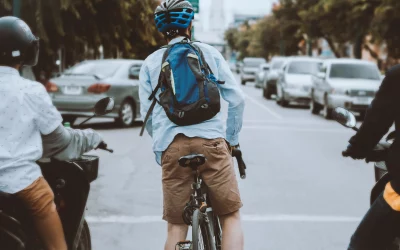TOP RATED BICYCLE ACCIDENT LAW FIRM
Cyclists confront several hazards on the road, the most serious of which being car collisions. Because bicycles provide far less protection than passenger autos, riders are especially vulnerable to damage and even death in car accidents.
This relative lack of safety also increases the dangers on the roads for bikers. When not handled appropriately, obstacles that are only an irritation to passenger vehicles–such as potholes and railroad track crossings–can inflict catastrophic damage to a bicycle and harm the rider.
We’ll discuss some of the most prevalent road-related risks for bicycles in this article and provide recommendations on preventing them.
Common Road Defect Cycling Accidents
POTHOLES
Potholes are among the most hazardous road conditions for bicycles due to their extreme prevalence and near impossibility to entirely be eliminated. As with the Hydra of Greek mythology, after one pothole is plugged, another appears overnight.
Riding into a pothole may result in various issues for cyclists, ranging from puncturing a tire to tossing the rider off the bike into oncoming traffic. Landing on a paved surface face-first may result in bruising and broken bones, while being struck by a moving car can be fatal.
The most efficient technique to avoid potholes is to ride around them, but this is not always possible, particularly on congested metropolitan routes. If you cannot swerve around a pothole, you should leap over it using the “bunny hop”1 move. How it works is as follows:
As you approach a pothole, adjust the pedal cranks level and elevate your bottom off the seat.
Position your hands on the handlebars and move your weight backward.
When you’re going to collide with a pothole, launch your torso and feet upward while simultaneously elevating your handlebars. This will lift the bike enough off the ground to hop over the pothole.
Naturally, leaping over such potholes requires practice. Ensure that you have mastered the technique in an empty parking lot before attempting it on the open road.
SLICK AREAS
Lines Painted: Painted streets may be slippery, particularly in areas with large markings such as pedestrian crossings. This is because the paint fills in the roughness of the asphalt, reducing your tires’ grip on the road, particularly while the paint is wet. Slow down and provide more time to stop when approaching pedestrian crossings and other painted markings.
Wet metal: When metal surfaces on the road (such as manhole covers and steel plates) are wet, they become as slippery as ice. When approaching wet metal, ride completely upright since even a tiny tilt might cause your wheels to slide and hurl you off your bike.
Like manhole covers and steel plates, sewer grates are metal and maybe rather slippery when wet. However, bicycles have another issue with sewage grates: They have long, rectangular holes capable of swallowing a bicycle tire and propelling the rider headfirst over the handlebars. Avoid colliding with sewage grates by not riding too deep into the gutter.
Biking through leaves is especially dangerous in the autumn when massive heaps of leaves suddenly cover the sides of a road. While dry leaves might help minimize friction between your bike’s tires and the road, this issue is worsened if the leaves are even slightly damp.
Since with any other slippery surface, slow down and ride straight through the leaves, as any tilt might cause your bike to slide out from beneath you.
TRAIN TRACKS
Like potholes, railroad tracks are very prevalent and difficult to avoid. Additionally, they cannot be ridden like some other threats. Thus you must understand how to cope with them. Slow down as you approach train tracks.
Railroad tracks are very rough surfaces, and even if you avoid a collision, they may damage a tire. Unlike potholes, railroad tracks, on the other hand, seldom spread, and there are nearly always warning signs alerting vehicles and cyclists to the presence of railroad tracks ahead.
Additionally, always cross-train lines at right angles to the road you are on, even if the tracks are diagonal to the road. When you cross railroad lines at an angle, it is quite easy for your front tire to get wrenched out from under you. Additionally, it is beneficial to raise slightly off your seat and use your arms and legs as shock absorbers.
INCONSISTENT SURFACES
Uneven surfaces, such as speed bumps, cobblestones, bricks, and gravel, are dangerous to bicycles due to their unpredictable nature. Unlike cyclists on smooth asphalt roads, cyclists on uneven surfaces have no notion what sort of terrain they are about to encounter.
The greatest approach for avoiding collisions when driving over bumpy and uneven ground is to rise slightly out of the seat and utilize your arms and legs as shock absorbers.
In this manner, your body will move naturally as the bike ascends and descends. If you often ride on tough terrain, you may also wish to consider bigger tires.
THE MOST COMMON INJURIES SUSTAINED BY CYCLISTS
Any of the road as mentioned above conditions might result in cyclist injury. Although we expect that the rider suffers just a punctured tire or a broken chain, bicycle accidents may result in bodily injury.
Limb injuries are the most prevalent cycling injury, with around 40% of riders experiencing arm injuries and approximately 25% suffering leg injuries.
Head injuries are the second most prevalent form of injury, with around 40% of cyclists suffering from at least one head injury over their lifetime.
Chest and abdominal injuries are the least prevalent form of cycling injury, occurring in approximately 5% of riders.
BICYCLE ACCIDENTS
Due to the rider’s lack of protection when riding a bicycle. While helmets, elbow, and knee pads offer some protection, they are limited in their effectiveness.
The Reasons for Bicycle Accidents on Defective Roads
Losing control of the bicycle is the leading cause of bicycle accidents on a bad road. A cyclist may lose control due to a pothole, a soft shoulder, inadequate illumination, or even a fissure in the road. Additional causes include:
Motorist errors such as missing signs or signals or a pothole that causes a motorist to lose control and collide with a bicyclist;
Speed when a bicyclist has the right of way and is unable to stop in time to avoid road debris, a
pothole, or a motorist running a stop sign or light; and
Environmental hazards such as loose gravel.
Different Types of Injuries
Road rash (abrasions), lacerations, and strains are all common injuries sustained in bicycle wrecks. While they are usually not dangerous, they may become so if an infection develops or the road rash is severe enough to necessitate skin grafts.
All injuries, no matter how slight, should be evaluated promptly. Even if you do not believe you have been wounded, you should still see a doctor since injuries might manifest themselves a day or more after the event.
Occasionally, bicycle accidents result in serious injury to bikers. Cycling accidents can result in the following types of injuries:
- Skull fractures;
- Concussions;
- Intracranial hemorrhage;
- Brain contusions;
- Facial fractures;
- Corneal foreign bodies;
- Contusions to the face and eyes;
- Dental fractures;
- Dislocations;
- Strains;
- Fractures to the arms, legs, and other body parts;
- Parenchymal lung injuries;
- Rib fractures;
- Traumatic hernias;
- Large or small bowel contusions;
- Renal contusions;
- Abdominal ruptures;
- Splenic ruptures;
- Pancreatic trauma;
- Hepatic lacerations;
- Vascular perforations;
- Urethral and vulval trauma; and
- Pelvic
Several of these may need months of recovery. Others have the potential to result in lifelong impairment. Even if you are hospitalized for some time after a bicycle accident, you should call a personal injury attorney immediately.
Bicycling is a common recreational activity for people of all ages, and bicycle-related accidents result in considerable morbidity and death. Males sustain the majority of injuries connected with riding at high speeds; the majority of severe injuries and deaths occur as a consequence of accidents with motor vehicles.
While superficial soft tissue and musculoskeletal injuries are the most prevalent types of injuries, head traumas account for most deaths and long-term disability. Overuse injuries may result in a range of musculoskeletal and compressive neuropathies and perineal and genital symptoms.
Physicians treating such individuals should consider medical issues and recommend changing different bicycle components, such as the seat height and handlebars. Encouraging cyclists to use helmets is critical for injury prevention; protective clothing and equipment and general safety advice may also provide some protection.
The Centers for Disease Control and Prevention reported that 72.7 percent of children aged five to fourteen years rode bicycles in 1994, totaling 27.7 million kid bikers. Off-road bicycles (mountain bicycles) currently account for 62% of new bicycle sales in the United States and are popular on metropolitan streets and rocky trails. Other sorts of bicycles include:
Sport/tour. Racing.
Bicycle motocross (BMX) stunt bicycles.
The growing popularity of stationary bicycles.
While bicycling is an excellent form of exercise and recreation, it, like any other activity, contains the danger of injury. The page discusses the causes and epidemiology of bicycle-related injuries and treatment and preventative techniques for common injuries.
INJURY INCIDENCE AND RISK FACTORS
INCIDENCE
Bicycle-related injuries occur in around 900 fatalities, 23,000 hospital hospitalizations, 580,000 emergency department visits, and over 1.2 million physician visits per year in the United States, totaling more than $8 billion.
According to the Child Health Supplement to the 1988 National Health Interview Survey, roughly 4.4 million children ages, five to seventeen were injured each year due to their engagement in sports and leisure; bicycle-related injuries accounted for between 10% and 40% of these.
Bicycle collisions are the second leading cause of serious injury in sports or leisure; one research assessed the incidence of severe injuries in metropolitan areas to be 37.4 per 100,000 inhabitants.
Although mountain cyclists of all ages account for just 3.7 percent of all bicycle accidents, up to 51% of leisure mountain bikers and 85% of competitive mountain bikers incur injuries each year. BMX bicycle riders often experience injuries when executing stunts, and 6.3 percent of BMX riders sustain injuries during competition.
FACTORS OF RISK
Bicycle-related injuries and deaths are most prevalent in the nine- to fifteen-year-old age range, with a male-to-female ratio of 2 to 3:1. Not wearing a helmet, being involved in collisions with motor vehicles, riding in an unsafe environment, and male sex are all significant risk factors for bicycle- related injuries.
The effect of socioeconomic status on the incidence of bicycle-related injuries is unclear—in some cases, an increased incidence of such injuries occurs in children from more educated households.
The majority of studies, however, do not account for the quantity of time spent riding. Alcohol and drug misuse may be connected with bicycle injury in teenagers and young adults.
ATTORNEY FOR BICYCLE ACCIDENT INJURIES
If you or a loved one has been harmed in a bicycle accident caused by a road problem, call The Colorado Law Group. Our lawyers have the knowledge and expertise necessary to get the compensation that bicycle accident victims deserve.
Compensation for a bicycle accident or the death of a loved one due to road flaws may include loss of consortium, loss of employment, medical costs for the accident and future medical expenditures for occupational and physical rehabilitation, lost income, and mental distress, among other things.
The easiest approach to determine your eligibility for compensation after a bicycle accident is to immediately speak with an expert bicycle accident attorney.
Contact a Bicycle Accident Attorney in Colorado Springs
If you have been injured in a bicycle accident, please contact the experts at Warrior Bicycle Accident Lawyers, for a free consultation. You may reach us by phone at 719-300-1100 or by email using our online contact form.







